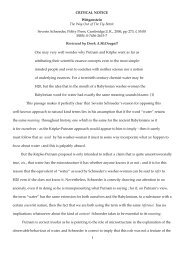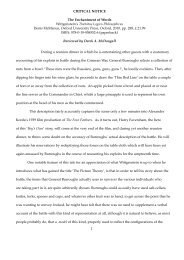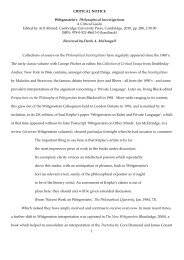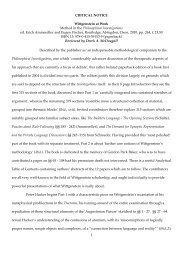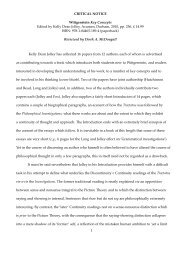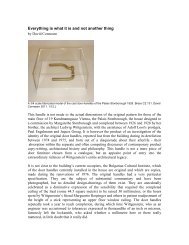The Evolution of the Private Language Argument Aldershot
The Evolution of the Private Language Argument Aldershot
The Evolution of the Private Language Argument Aldershot
You also want an ePaper? Increase the reach of your titles
YUMPU automatically turns print PDFs into web optimized ePapers that Google loves.
that we cannot even envisage a language which is not intrinsically public, for that in accordancewith <strong>the</strong> criterionless aspect <strong>of</strong> first person sensation ascription is something that has no sense.It is important, <strong>the</strong>refore, to distinguish <strong>the</strong> question <strong>of</strong> how our sensation termsacquire meaning in practice, from <strong>the</strong> distinct question <strong>of</strong> <strong>the</strong> nature <strong>of</strong> first person sensationascription, and whilst Wittgenstein tends to treat <strong>the</strong>m toge<strong>the</strong>r as in <strong>the</strong> last paragraph <strong>of</strong> § 288,<strong>the</strong> issues are quite separate. It is for this reason that if we cut out human behaviour as <strong>the</strong>expression <strong>of</strong> sensation, <strong>the</strong>n it seems we might legitimately doubt afresh only if we are preparedto abandon <strong>the</strong> model <strong>of</strong> first person criterionless sensation ascription in favour <strong>of</strong> <strong>the</strong> model <strong>of</strong>a private object. But that model is illusory, and whilst <strong>the</strong> fantasies <strong>of</strong> Ayer and Kripke are indeedan expression <strong>of</strong> <strong>the</strong> Augustinian picture, <strong>the</strong>y still make sense. <strong>The</strong> fact that <strong>the</strong>y do also reveals<strong>the</strong> extent to which Colin McGinn, for example, goes astray in concluding that Wittgenstein‘invites us to believe that someone whose sensations happen to have no behavioral expressionis semantically impotent in respect <strong>of</strong> those sensations.’ (30) But McGinn is assuming that whatis being provided by Wittgenstein here is a logical argument, when he is doing no more thanissue a reminder <strong>of</strong> <strong>the</strong> circumstances in which we learn how sensation terms are applied.So how far does this account approximate to Kenny’s succinct treatment <strong>of</strong> <strong>the</strong>relevant passages in <strong>the</strong> Investigations ? <strong>The</strong> salient point is actually one that Neilsen findsra<strong>the</strong>r too subtle, one in which Kenny ‘sacrificed clarity for compactness’. (30) <strong>The</strong> referenceis to § 270, and Kenny’s rejection <strong>of</strong> <strong>the</strong> ‘intermediate step’ between having <strong>the</strong> sensation andjudging that one’s blood pressure is rising, a step which would consist in recognising <strong>the</strong>sensation as a sensation <strong>of</strong> a particular kind, prior to judging that this kind <strong>of</strong> sensationindicates a rise in blood pressure. But if this is a normal sensation <strong>of</strong> a particular kind, <strong>the</strong>recan be no intermediate (private) step: <strong>the</strong> distinction between recognising a sensation priorto describing is one that has no application to our ordinary sensation language. <strong>The</strong> differencebetween § 270 and § 258, <strong>the</strong>refore, is that § 258 presents <strong>the</strong> idea <strong>of</strong> a sensation that is notalready an ordinary sensation <strong>of</strong> a particular kind, a sensation which has effectively to be24






